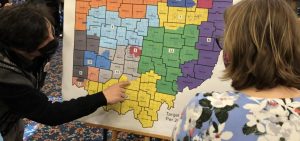News
Unconstitutional congressional map from last year will be used in Ohio next year too
By: Karen Kasler | Statehouse News Bureau
Posted on:
COLUMBUS, Ohio (Statehouse News Bureau) — The 15-member congressional map that was used last year will be used again next year, even though it was ruled unconstitutionally gerrymandered. That’s after the Ohio Supreme Court agreed to dismiss challenges to that map filed by a coalition of groups that are opposed to it.

Jen Miller with the League of Women Voters of Ohio said they’re also going to focus on the process of drawing maps for the Ohio House and Senate. Republican Secretary of State Frank LaRose, a member of the Ohio Redistricting Commission which draws the maps, has said those legislative maps should be done by Sept. 22 and must be done by Oct. 23.
“Litigation is expensive and time consuming and does not necessarily mean better results for voters,” Miller said. “So we petitioned the Supreme Court of Ohio to dismiss the case, recognizing that we would better use our time by advocating for fair Ohio Senate and Ohio House maps, as well as collecting signatures to get politicians completely out of the process through the citizens not politicians amendment.”
The U.S. Supreme Court had ordered the Ohio Supreme Court to review its ruling that the congressional map was unconstitutionally gerrymandered after the decision in Moore v. Harper in June. In that case from North Carolina, the U.S. Supreme Court rejected the independent state legislature theory, which contended that state lawmakers have ultimate power in regulating federal elections, not state courts.
There was also concern from activists that if a new map were ordered, the final product would be worse than the current one. When Republicans drew that map last year, it was expected to result in 13 GOP and 2 Democratic wins. But the final result was 10 Republicans and 5 Democrats were elected. That Republican-approved map will have to be redrawn after the 2024 election because a map without bipartisan support could only be in place for four years.
Republicans are pointing out that the U.S. Supreme Court’s ruling vacated the Ohio Supreme Court’s decision ruling the congressional map is unconstitutional.
A spokesman for Senate President Matt Huffman (R-Lima), who had been a member of the Ohio Redistricting Commission and played a key role in creating the constitutional amendments that created it, said in a statement: “Following months of rancor from far left special interests those same organizations decided it was no longer in their best interest to litigate after the U.S. Supreme Court vacated the earlier 4-3 opinion under Ohio’s former Chief Justice. We hope our colleagues on the other side of aisle reject orders from Eric Holder’s NDRC and big Washington, D.C., liberal law firms, rejoin good faith negotiations in the future and give the process approved by the voters a chance to work.”

